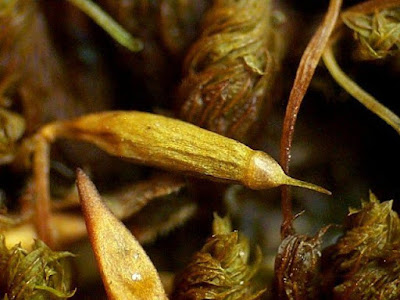.The edge of a drying pond would hardly seem like a hospitable place for plant life. During the wet season it is submerged, and during the dry season it can be completely dried out. Yet for the few months when the shoreline is retreating, during winter and spring in Florida, the sandy soil between high and low water marks remains moist, and supports a variety of small, but quick-growing plants that complete their life cycles before being inundated again.
 |
Some green plants can be seen along this drying pond edge, but
the most interesting residents can only be seen close-up. |
I have previously reported on some ephemeral inhabitants of such pond edges, including the sundew,
Drosera capillaris, and several mosses, including
Rosulabryum capillare,
Physcomitrium collenchymum, and some species of
Micromitrium. I expect to report on several other mosses with similar habits in the coming months.
.
Recently, I was out walking in my neighborhood, and decided to revisit the same pond edge where I had collected
Physcomitrium collenchymum in late March a couple of years ago. Now, in late January, I was quite surprised to find two completely different bryophytes,
Riccia cavernosa, and
a species of
Sphaerocarpos - both liverworts - but no sign of the
Physcomitrium. I shall have to pay attention over the next several months, to see if there is a succession of different species that might include later appearances of a moss or two.
 |
| Riccia forms a flat, forking thallus, while Sphaerocarpos takes the form of a rounded mound of upright shoots. |
.
 |
| Riccia cavernosa is a thallose liverwort, meaning its body is in the form of a flattened, forking ribbon. Riccia species tend to spread outward from a central point, forming a round disk, at least when young, One can see here that the thallus is heavily pitted, giving it a spongy texture. |
 |
| Sphaerocarpos species form cushions of odd egg-shaped shoots. |
.
.Finding these liverworts got me to thinking again about the very first land plants, which most likely lived in a similar habitat, and were similar in growth forms to modern thallose liverwort like
Riccia. Phylogenetic studies indicate that the closest living relatives of land plants are in the green algal genus
Coleochaete, which has a similar flat, disk-like growth form. So it is easy to see an ancient transition from one to the other.
 |
The green alga, Coleochaete, grows as
a flat sheet of tissue (A,B) that expands
outward from its center. The roundish
bodies are zygotes, that will eventually
undergo meiosis to produce zoospores (C).
from Essig 2015, after Haupt. |
To be sure, some major adaptive innovations took place as green algae moved onto land, especially in their mode of reproduction.
Coleochaete, like other green algae, produces zoospores through meiosis of the zygote, while all bryophytes have a diploid sporophyte generation that produces non-motile, dessication-resistant spores through meiosis of cells within a spore chamber or capsule.
[several interesting copyrighted photos of
Coleochaete species can be seen at The
Vine Tendril , and
The Algal Web.
Also to be sure,
Riccia is a modern liverwort genus, and I don't suggest that the first land plant were members of that genus that have been sitting around unchanged for 400 million years. Most likely the ancestors of
Riccia readapted to this habitat, as many others have over the ages, including the
Sphaerocarpos, various mosses, and certainly the
Drosera.
Part of that readaptation, is a shift back to the means of spore dispersal most likely practiced by the first land plants. In most bryophytes, the spore capsule is elevated by a stalk to facilitate wind-dispersal. The spore chamber of
Riccia is however very simple and lacks a stalk. It remains embedded within the thallus until the latter disintegrates, and the spores are then dispersed by water currents as the pond level rises, or on the feet of birds walking around in the mud. Seeds of
Drosera capillaris are probably dispersed in a similar way.
 |
The sporophyte of Riccia is embedded within the gametophyte
thallus. It consists of a thin wall (the capsule) containing a mass
of diploid tissue, which here has been transformed through
meiotic division into a number of hard-walled spores. From
Essig 2015, after Brown. |
So the water-edge habitat has continued to host a dynamic community of ephemeral plants of similar growth form and reproductive habits since the very first colonization of the land.
Reference:
Essig, Frederick B., 2015. Plant Life - a Brief History. Oxford University Press.
.
.
.
.
.
.
.
.
.











